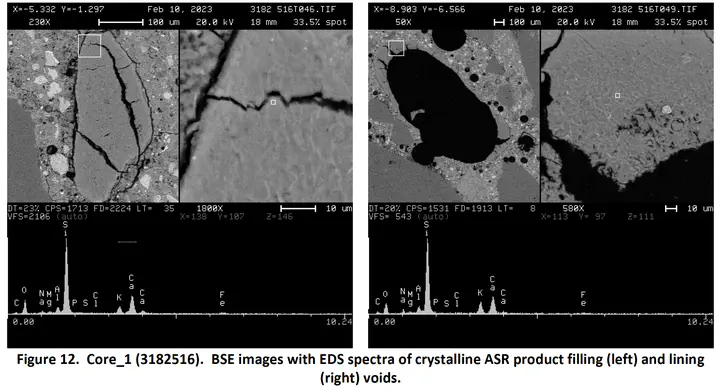Effective concrete mixes for Saskatchewan sidewalks using locally available pop-out prone aggregates

Background
In cold climates, damage in concrete infrastructure caused by freezing and thawing cycles, is one of the major problems that require special attention to minimize its severity, and hence, reduce the costs for the repair and replacement of structures over their life cycle. The causes of deterioration of hardened concrete by frost damage have been shown to be related to both the severity of the environmental service conditions as well as to the microstructure of the concrete material itself. The most common form of frost damage that can take place in concrete is due to the expansion of the cement paste matrix that leads to cracking and spalling of concrete when subjected to repeated freezing and thawing cycles. For instance, in the presence of moisture and de-icing salts, concrete slabs exposed to freezing and thawing cycles can be prone to the phenomenon of scaling of the finished surface. Another frost damage that affects some types of coarse aggregates in concrete slabs is the formation of D cracking, parallel to the joints and edges in a pattern resembling the letter D. This type of cracking is also referred to as durability cracking. The other frost damage, commonly caused by aggregates, is pop-outs. The causes of aggregate pop-outs can be due to physical action, such as freeze and thaw cycles, or chemical action, as in the case of alkali silica reactions. The risk of damage to the cement paste of concrete by frost action has been shown to be controllable by the use of air entraining agents.
In Saskatchewan, pop-outs are mainly associated with soft, absorbent aggregates and or with alkali reactive aggregates, present in concrete. These low-quality aggregates can be found throughout Central North America. Although the Canadian Standards Association (CSA) imposes restrictions on the amounts of the deleterious materials allowed in concrete, for obvious practical reasons, these limits do not eliminate completely the presence of “bad aggregates”, and hence, some pop-outs can still occur. Various reports have documented this scarcity of good quality aggregates in Saskatchewan, as early as the 1960s. This shortage of good quality aggregates is rather widespread in the province, which prompted The Ministry of Highways and Infrastructure, as well as many municipalities to develop a lot of experience and knowledge in the use of pop-out prone aggregates for various applications (pavement surfaces, sidewalks, etc.) exposed to freeze/thaw cycles, often in the form of specifications, materials engineering, and standards.
Although the recommended guidelines and specifications do cover the main procedures that would typically help alleviate the shortcomings associated with the use of pop-out prone aggregates, pop-outs remains a common sight in Saskatchewan. This is the case because when the exact nature of the pop-out problem and/or its severity for a given source of aggregates are not well understood combined with the large number of possible recommendations to mitigate the problem (Limits on the amount of deleterious materials, lowering of water content and slump, use of air entraining admixtures, good practice for finishing concrete, surface water management (drainage, slopping, etc.), and the difficulty to use some of them in certain applications, all contribute to the persistence of this problem in Saskatchewan. This is especially the case for applications where the high costs of high-quality aggregates are hard to justify. In this kind of applications, a more effective approach would be to identify the root causes of the observed frost damage in the available aggregates and come up with a cost-effective strategy to mitigate the pop-out problem with the given source of aggregate, as proposed in this study.
Research outcomes
The research identified the root causes of observed frost damage in local aggregates and prescribed a cost-effective strategy to mitigate the pop-out problem severely affecting a large number of sidewalks in Saskatchewan.